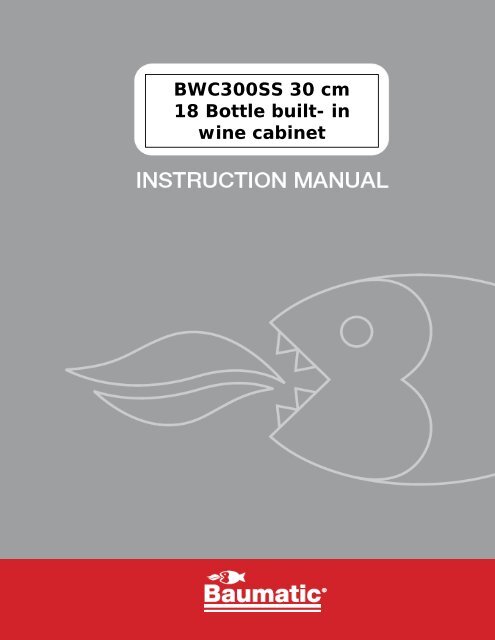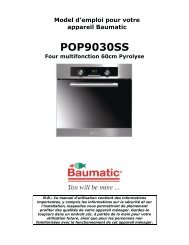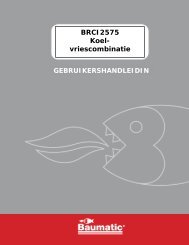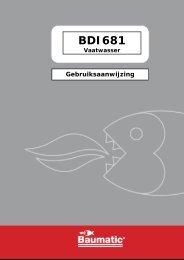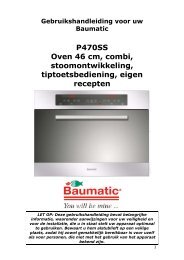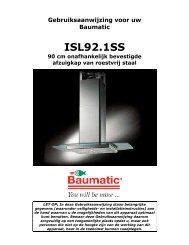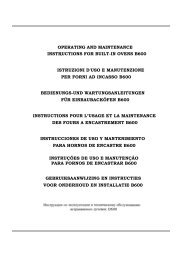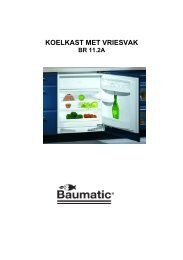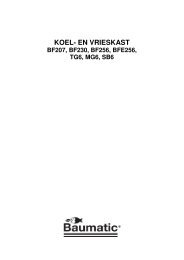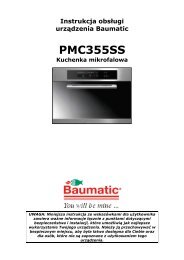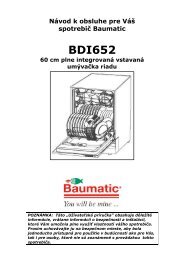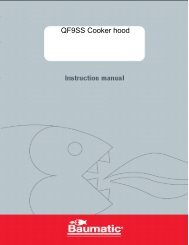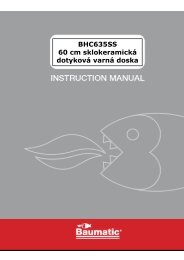BWC300SS 30 cm 18 Bottle built- in wine cabinet - Baumatic
BWC300SS 30 cm 18 Bottle built- in wine cabinet - Baumatic
BWC300SS 30 cm 18 Bottle built- in wine cabinet - Baumatic
You also want an ePaper? Increase the reach of your titles
YUMPU automatically turns print PDFs into web optimized ePapers that Google loves.
<strong>BWC<strong>30</strong>0SS</strong> <strong>30</strong> <strong>cm</strong><br />
<strong>18</strong> <strong>Bottle</strong> <strong>built</strong>- <strong>in</strong><br />
w<strong>in</strong>e cab<strong>in</strong>et
USER MANUAL FOR YOUR BAUMATIC<br />
<strong>BWC<strong>30</strong>0SS</strong><br />
<strong>30</strong> <strong>cm</strong> <strong>18</strong> <strong>Bottle</strong> <strong>built</strong>-<strong>in</strong><br />
w<strong>in</strong>e cab<strong>in</strong>et<br />
NOTE: This User Instruction Manual conta<strong>in</strong>s important<br />
<strong>in</strong>formation, <strong>in</strong>clud<strong>in</strong>g safety & <strong>in</strong>stallation po<strong>in</strong>ts, which will<br />
enable you to get the most out of your appliance. Please keep it<br />
<strong>in</strong> a safe place so that it is easily available for future reference, for<br />
you or any person not familiar with the operation of the appliance.<br />
GS 04/10/12<br />
2
Contents<br />
Environmental note 4<br />
Important safety <strong>in</strong>formation 5 – 6<br />
Specifications of your w<strong>in</strong>e cab<strong>in</strong>et 7 – 8<br />
Dimensions 7<br />
Product specifications 7 - 8<br />
Description of the appliance 8-10<br />
Product features 8<br />
Control panel 9<br />
Description of the product features 9-10<br />
Us<strong>in</strong>g your <strong>Baumatic</strong> w<strong>in</strong>e cab<strong>in</strong>et 10-13<br />
Before switch<strong>in</strong>g on 10<br />
Dur<strong>in</strong>g first use 11<br />
Switch<strong>in</strong>g on the appliance and sett<strong>in</strong>g the temperature 11-12<br />
Chang<strong>in</strong>g between Fahrenheit and Celsius 12<br />
The humidity control box (optional) 12<br />
Load<strong>in</strong>g the w<strong>in</strong>e cab<strong>in</strong>et 12-13<br />
Stor<strong>in</strong>g your w<strong>in</strong>es 13-14<br />
W<strong>in</strong>e storage problems 15<br />
Clean<strong>in</strong>g and ma<strong>in</strong>tenance 16-<strong>18</strong><br />
Defrost<strong>in</strong>g 16-17<br />
Remov<strong>in</strong>g the shelves for clean<strong>in</strong>g 17<br />
Mov<strong>in</strong>g your w<strong>in</strong>e cab<strong>in</strong>et 17<br />
Power failure <strong>18</strong><br />
Vacation time <strong>18</strong><br />
Installation <strong>18</strong>-25<br />
Electrical connection 19<br />
Position<strong>in</strong>g 19-20<br />
Built-<strong>in</strong> <strong>in</strong>stallation 21<br />
Adjust<strong>in</strong>g the height and levell<strong>in</strong>g off your w<strong>in</strong>e cab<strong>in</strong>et 22<br />
Install<strong>in</strong>g the handle 23<br />
Revers<strong>in</strong>g the door of your w<strong>in</strong>e cab<strong>in</strong>et 23-25<br />
Troubleshoot<strong>in</strong>g 25-26<br />
<strong>Baumatic</strong> consumables 27<br />
Technical data 28<br />
Contact details 29<br />
3
Environmental note<br />
Note: Before discard<strong>in</strong>g an old appliance, switch off and<br />
disconnect it from the power supply. Cut off and render any plug<br />
useless. Cut the cable off directly beh<strong>in</strong>d the appliance to prevent<br />
misuse. This should be undertaken by a competent person. Disable<br />
the door lock to make sure that children cannot get stuck <strong>in</strong>side<br />
the appliance.<br />
o The packag<strong>in</strong>g materials that <strong>Baumatic</strong> uses are environmentally<br />
friendly and can be recycled.<br />
o Please discard all packag<strong>in</strong>g material with due regard for the<br />
environment.<br />
4
Important safety <strong>in</strong>formation<br />
Use of the appliance<br />
Your safety is of the utmost importance to <strong>Baumatic</strong>.<br />
Please make sure that you read this <strong>in</strong>struction booklet<br />
before attempt<strong>in</strong>g to <strong>in</strong>stall or use the appliance. If<br />
you are unsure of any of the <strong>in</strong>formation conta<strong>in</strong>ed <strong>in</strong><br />
this booklet, please contact the <strong>Baumatic</strong> Advice L<strong>in</strong>e.<br />
IMPORTANT: Any <strong>in</strong>stallation work must be<br />
carried out by a qualified electrician or<br />
competent person.<br />
o Your appliance is only designed to be used <strong>in</strong> the<br />
home. It is suitable for stor<strong>in</strong>g and chill<strong>in</strong>g w<strong>in</strong>e.<br />
NO food stuffs must be stored <strong>in</strong> the appliance. If it<br />
is used for any other purpose or it is not used<br />
correctly, then <strong>Baumatic</strong> Ltd. will accept no liability<br />
for any damage that is caused.<br />
o Alter<strong>in</strong>g the specification of the appliance must not be attempted<br />
for reasons of safety.<br />
Before us<strong>in</strong>g your appliance<br />
o Check the appliance for any signs of transport damage. If you<br />
notice any damage, then you should not connect your appliance<br />
to your ma<strong>in</strong>s supply and should contact your retailer.<br />
Refrigerant<br />
o Your appliance conta<strong>in</strong>s R600a refrigerant, which is a natural gas<br />
that does not conta<strong>in</strong> CFCs that can damage the environment.<br />
However it is a flammable substance, therefore care should be<br />
taken:<br />
Dur<strong>in</strong>g the transportation and <strong>in</strong>stallation of the<br />
appliance, make sure that the refrigeration pipework<br />
does not get damaged.<br />
If it does become damaged then sources of ignition<br />
and open flames should be avoided. Also the room<br />
that the appliance is situated <strong>in</strong> should be thoroughly<br />
ventilated.<br />
o Do not place any objects on top of the appliance,<br />
as this may damage the table top.<br />
5
Child safety<br />
o Packag<strong>in</strong>g material should be kept away from<br />
children.<br />
o Children should not be allowed to touch the<br />
controls or play with the appliance.<br />
General safety<br />
o Do not pull on the power supply cable to remove the plug from<br />
your ma<strong>in</strong>s supply socket.<br />
o Do not pull out or <strong>in</strong>sert the plug with wet hands.<br />
o Do not attempt to use your appliance outdoors or<br />
any place where it is likely to come <strong>in</strong>to contact<br />
with the elements.<br />
o Before clean<strong>in</strong>g the appliance or perform<strong>in</strong>g<br />
ma<strong>in</strong>tenance work, ensure that the appliance has been<br />
disconnected from your ma<strong>in</strong>s supply.<br />
o Never allow the back coils of the appliance to come <strong>in</strong>to contact<br />
with the wall surface.<br />
o Always ensure that the location where you are <strong>in</strong>stall<strong>in</strong>g your<br />
appliance is free of stored items such as papers and other<br />
flammable materials.<br />
o Never block the ventilation open<strong>in</strong>gs of the appliance, either on<br />
the <strong>in</strong>side or its exterior.<br />
o It is vital to keep your appliance well ventilated,<br />
so that there is proper air flow between the<br />
bottom of the unit and the pl<strong>in</strong>th/kick plate<br />
which it is sitt<strong>in</strong>g on.<br />
o Do not place electrical devices <strong>in</strong>side of the appliance, such as<br />
mixers or ice cream makers.<br />
Service<br />
You should not attempt to repair the appliance<br />
yourself, as this could cause <strong>in</strong>jury or a more serious<br />
malfunction. If you require a service call then please<br />
contact the Customer Care Department.<br />
6
Specifications of your w<strong>in</strong>e cab<strong>in</strong>et<br />
Dimensions of appliance Dimensions of aperture*<br />
Height: 870 - 890 mm<br />
Width: 295 mm<br />
Depth: 570 mm<br />
Height: 875 mm<br />
Width: <strong>30</strong>0 mm (m<strong>in</strong>)<br />
Depth: 590 mm (m<strong>in</strong>)<br />
o Gross capacity: 58 litres<br />
o Net capacity: 56 litres<br />
o <strong>Bottle</strong> capacity: <strong>18</strong> x 0.75 litre Bordeaux style w<strong>in</strong>e bottles<br />
o Energy efficiency class: B<br />
o Noise level: 39 dB<br />
o Electronic push button control operation<br />
o LED display<br />
o Celsius and Fahrenheit option<br />
o 6 Adjustable wooden shelves<br />
o Adjustable temperature<br />
o Digital thermometer<br />
o Humidity control box<br />
o Internal light<br />
o Black exterior<br />
o Water dra<strong>in</strong>age<br />
o Fan assisted operation<br />
o Quiet operation (39 dB)<br />
o Adjustable feet<br />
o Reversible door<br />
7
o Tempered glass door<br />
o Sta<strong>in</strong>less steel door frame and handle<br />
o Designed to store w<strong>in</strong>e at its optimum temperature between 5°C<br />
- 22°C.<br />
* Please refer to the <strong>in</strong>stallation <strong>in</strong>structions for more specific<br />
<strong>in</strong>formation on the size of aperture that you will require.<br />
IMPORTANT: When you <strong>in</strong>stall your appliance it is important to bear<br />
<strong>in</strong> m<strong>in</strong>d its climatic rat<strong>in</strong>g.<br />
In order to f<strong>in</strong>d out the climatic rat<strong>in</strong>g of your appliance, you should<br />
check the rat<strong>in</strong>g plate. The rat<strong>in</strong>g plate is located on the front left edge<br />
of the appliance. The rat<strong>in</strong>g plate will <strong>in</strong>dicate the ambient temperature<br />
range that your appliance will function correctly with<strong>in</strong>. It is also<br />
advisable to make a note of the model number and the serial number<br />
of the appliance before <strong>in</strong>stall<strong>in</strong>g it.<br />
Model number ………………………………………………<br />
Serial number ………………………………………………<br />
Date of purchase ……………………………………………..<br />
Description of the appliance<br />
Product features<br />
1) Digital control<br />
panel<br />
2) Sta<strong>in</strong>less steel<br />
door<br />
3) Sta<strong>in</strong>less steel<br />
handle<br />
4) Adjustable<br />
shelves<br />
5) Adjustable foot<br />
8
Control panel<br />
The control panel is located <strong>in</strong> the middle of the appliance.<br />
1) ON / OFF control button<br />
2) Light control button<br />
3) Temperature display<br />
4) Temperature plus button<br />
5) Temperature m<strong>in</strong>us button<br />
Description of the product features<br />
Control panel<br />
o The control panel is located at the top of the appliance, beh<strong>in</strong>d<br />
the glass door. This means it is easy to set the temperature of<br />
the appliance and see what temperature the appliance is set to.<br />
One cool<strong>in</strong>g zone<br />
o There is one cool<strong>in</strong>g zone <strong>in</strong>side of your w<strong>in</strong>e cab<strong>in</strong>et.<br />
o The cool<strong>in</strong>g zone has a temperature control and temperature<br />
display.<br />
Interior light<br />
o The cool<strong>in</strong>g zone has an <strong>in</strong>terior light. The light can be switched<br />
on and off by us<strong>in</strong>g the light control button (2).<br />
9
The w<strong>in</strong>e cab<strong>in</strong>et shelves<br />
o The wooden shelves are fully adjustable to suit various w<strong>in</strong>e<br />
bottle shapes and sizes.<br />
o To prevent damag<strong>in</strong>g the door gasket, make sure the door is<br />
fully open when pull<strong>in</strong>g shelves out of the rail compartment.<br />
o For easy access to the bottles stored, pull the shelves out<br />
approximately 1/3 of the way.<br />
Us<strong>in</strong>g your <strong>Baumatic</strong> w<strong>in</strong>e cab<strong>in</strong>et<br />
Before switch<strong>in</strong>g on<br />
o Make sure that it has been <strong>in</strong>stalled by a suitably qualified<br />
person, as per the <strong>in</strong>formation conta<strong>in</strong>ed <strong>in</strong> <strong>Baumatic</strong>’s<br />
<strong>in</strong>stallation <strong>in</strong>structions.<br />
o After delivery, wait for eight hours before connect<strong>in</strong>g the<br />
appliance to your ma<strong>in</strong>s supply. This will allow any refrigerant<br />
gasses that may have been disturbed dur<strong>in</strong>g the transportation<br />
process to settle.<br />
o The outside of the appliance and the removable accessories<br />
conta<strong>in</strong>ed with<strong>in</strong> it, should be cleaned with a solution of liquid<br />
detergent and water.<br />
o The <strong>in</strong>terior of the appliance should be cleaned<br />
with a solution of sodium bicarbonate dissolved <strong>in</strong><br />
lukewarm water. The <strong>in</strong>terior and accessories<br />
should be thoroughly dried, after the clean<strong>in</strong>g<br />
process has been completed.<br />
o There can be an odour when you first switch on the appliance. It<br />
will lessen as the appliance starts to cool.<br />
10
Dur<strong>in</strong>g first use<br />
IMPORTANT: When you use the w<strong>in</strong>e cab<strong>in</strong>et for the first time<br />
or restart the appliance after it has been turned off for a long<br />
time, there could be a few degrees variance between the<br />
temperature you select and the one <strong>in</strong>dicated on the LED<br />
display. This is normal and it is due to the length of activation<br />
time. Once the w<strong>in</strong>e cab<strong>in</strong>et has been runn<strong>in</strong>g for a few hours<br />
everyth<strong>in</strong>g will be back to normal.<br />
o When you first switch on the appliance, the compressor will run<br />
cont<strong>in</strong>uously until the w<strong>in</strong>e cab<strong>in</strong>et reaches a cool enough<br />
temperature.<br />
o Dur<strong>in</strong>g this period of time, you should try not to open the door<br />
frequently or place bottles <strong>in</strong>side of the appliance.<br />
o If the unit is switched off or unplugged, you must allow at least 5<br />
m<strong>in</strong>utes before restart<strong>in</strong>g the appliance or reconnect<strong>in</strong>g it to<br />
your ma<strong>in</strong>s supply.<br />
Switch<strong>in</strong>g on the appliance and sett<strong>in</strong>g the temperature<br />
o To switch the appliance on, press the ON / OFF control button<br />
(1) for 5 seconds.<br />
o The temperature sett<strong>in</strong>g for the appliance is adjustable with<strong>in</strong><br />
the range of 5°C - 22°C / 40°F - 71°F.<br />
o When you press the temperature plus (4) or m<strong>in</strong>us (5) button<br />
for the first time, the LED display will show the factory default<br />
temperature sett<strong>in</strong>g of 12°C / 54°F for the cab<strong>in</strong>et.<br />
o Use the temperature plus (4) and m<strong>in</strong>us (5) buttons to set the<br />
desired <strong>in</strong>ternal temperature.<br />
o The temperature will <strong>in</strong>crease by 1°C or 1°F if you touch the plus<br />
button once and will decrease by the same amount if you press<br />
the m<strong>in</strong>us button once.<br />
o When you set a new temperature, the display will show the<br />
previous temperature for 5 m<strong>in</strong>utes, before show<strong>in</strong>g the actual<br />
cab<strong>in</strong>et temperature. Dur<strong>in</strong>g this time, the cab<strong>in</strong>et temperature<br />
will adjust accord<strong>in</strong>gly.<br />
o To view the set temperature at any time, press the plus (4) or<br />
m<strong>in</strong>us (5) button. The display will flash the temperature for 5<br />
seconds.<br />
11
IMPORTANT: When the temperature of the cab<strong>in</strong>et is changed,<br />
the compressor works harder to reach the required<br />
temperature. Dur<strong>in</strong>g this time, the side panels of the w<strong>in</strong>e<br />
cab<strong>in</strong>et can reach up to 45°C however they will cool down<br />
when the set temperature is reached.<br />
Chang<strong>in</strong>g between Fahrenheit and Celsius<br />
o You can select whether the temperature display shows Celsius or<br />
Fahrenheit.<br />
o To alter what the temperature display is show<strong>in</strong>g, press the plus<br />
button (4) for 5 seconds.<br />
o You cannot change the display if you are <strong>in</strong> the process of<br />
adjust<strong>in</strong>g the temperature of the w<strong>in</strong>e cab<strong>in</strong>et.<br />
The humidity control box (optional)<br />
The w<strong>in</strong>e cab<strong>in</strong>et is equipped with a system for ma<strong>in</strong>ta<strong>in</strong><strong>in</strong>g the correct<br />
level of humidity for w<strong>in</strong>e storage.<br />
o Fill the small plastic reservoir (humidity box) ¾ full with water<br />
and replace. The humidity box is located on the top shelf<br />
and secured by runners.<br />
o Check the water level regularly and refill as necessary.<br />
o IMPORTANT: Please ensure the reservoir is positioned<br />
correctly on the runners to avoid the possibility of water<br />
spillage.<br />
Load<strong>in</strong>g the w<strong>in</strong>e cab<strong>in</strong>et<br />
o IMPORTANT: Your appliance is ideally suited to store<br />
0.75 litre Bordeaux style w<strong>in</strong>e bottles. While it can<br />
store larger bottles, you must make sure that they do<br />
not prevent the door from shutt<strong>in</strong>g properly.<br />
o Always check that you can close the door without it foul<strong>in</strong>g on<br />
a w<strong>in</strong>e bottle, before shutt<strong>in</strong>g it.<br />
o When load<strong>in</strong>g several bottles of w<strong>in</strong>e at once, it will take<br />
longer for the appliance to cool the <strong>in</strong>dividual bottles.<br />
o As many bottles may differ <strong>in</strong> size and dimensions, the actual<br />
number of bottles you are able to store may vary. The<br />
12
maximum storage number is based on standard 0.75 litre<br />
Bordeaux style w<strong>in</strong>e bottles.<br />
o You can place <strong>18</strong> standard bottles <strong>in</strong> your appliance with 3<br />
bottles on each shelf.<br />
Stor<strong>in</strong>g your w<strong>in</strong>es<br />
The chart below <strong>in</strong>dicates the ideal storage temperatures for different<br />
types of w<strong>in</strong>e:-<br />
Type of w<strong>in</strong>e Temperature<br />
Temperature<br />
(Celsius)<br />
(Fahrenheit)<br />
Red w<strong>in</strong>e (*) 15.5 – <strong>18</strong>.5°C 59.9 – 65.3°F<br />
White w<strong>in</strong>e (**) 10 - 15°C 50 – 59°F<br />
Sparkl<strong>in</strong>g<br />
w<strong>in</strong>es/champagne<br />
7.2 – 9.5°C 45 – 49.1°F<br />
Rose w<strong>in</strong>e 9.5 – 10.5°C 49.1 – 50.9°F<br />
V<strong>in</strong>tage w<strong>in</strong>e 13°C 55°F<br />
* Light red w<strong>in</strong>es, such as Beaujolais, P<strong>in</strong>ot Noir and Cabernet Franc<br />
benefit from be<strong>in</strong>g served slightly cooler than full-bodied reds.<br />
** Chardonnay is often served too cold. You should chill it at a warmer<br />
temperature <strong>in</strong>side of your w<strong>in</strong>e cab<strong>in</strong>et. Or leave it to warm slightly<br />
when you remove it from your w<strong>in</strong>e cab<strong>in</strong>et.<br />
13
o Temperature stability is the most important factor when it comes<br />
to stor<strong>in</strong>g w<strong>in</strong>e.<br />
o Exposure to light, vibrations or fluctuations <strong>in</strong> temperature and<br />
humidity can all cause w<strong>in</strong>e to spoil. When properly stored,<br />
w<strong>in</strong>es not only ma<strong>in</strong>ta<strong>in</strong> their quality but many will actually<br />
improve <strong>in</strong> aroma, flavour and complexity as they mature.<br />
o W<strong>in</strong>es kept at a higher temperature will age faster. W<strong>in</strong>e that is<br />
exposed to temperatures that are greater than 21°C (70°F) will<br />
suffer from poorer flavour and aroma.<br />
o If w<strong>in</strong>e is kept at too low a temperature, this can result <strong>in</strong> the<br />
development of harmful deposits. A humidity of 70% is ideal for<br />
keep<strong>in</strong>g corks from shr<strong>in</strong>k<strong>in</strong>g.<br />
o After a bottle of w<strong>in</strong>e has been opened, the w<strong>in</strong>e comes <strong>in</strong>to<br />
contact with air. So it is best to store the rema<strong>in</strong>der of the bottle<br />
upright, to m<strong>in</strong>imize the surface area of the w<strong>in</strong>e that is com<strong>in</strong>g<br />
<strong>in</strong>to contact with the air.<br />
o Once opened, w<strong>in</strong>e will rema<strong>in</strong> <strong>in</strong> a dr<strong>in</strong>kable condition for two<br />
days for delicate whites or three days for rich reds, as long as<br />
the bottle as been resealed. You should make sure that the seal<br />
is firm by check<strong>in</strong>g the stopper.<br />
o Special stoppers that keep w<strong>in</strong>e sparkl<strong>in</strong>g and Champagne<br />
bubbl<strong>in</strong>g for one or two days after open<strong>in</strong>g, can be bought at<br />
most good w<strong>in</strong>e shops.<br />
o When stored correctly, white w<strong>in</strong>es can keep well for up to two<br />
years. Full bodied reds will age well for ten years and dessert<br />
w<strong>in</strong>es will age well for up to twenty years.<br />
o When you buy a bottle of w<strong>in</strong>e, you should transfer it to a<br />
suitable storage location immediately (if you are not go<strong>in</strong>g to<br />
store it <strong>in</strong> your w<strong>in</strong>e cab<strong>in</strong>et).<br />
o Cheaper bottles of w<strong>in</strong>e will not age as well as more expensive<br />
ones.<br />
o To make the most of the bouquet and taste of your w<strong>in</strong>e, never<br />
fill more than half a glass at a time. It will also help if the shape<br />
of your w<strong>in</strong>e glass is appropriate for your w<strong>in</strong>e. The size and<br />
shape of your w<strong>in</strong>e glass’s bowl will determ<strong>in</strong>e the <strong>in</strong>tensity and<br />
complexity of the bouquet. The stem should be long enough to<br />
allow you to avoid hand contact with the bowl of the glass and<br />
should be tulip-shaped or tapered at the top.<br />
14
W<strong>in</strong>e storage problems<br />
Cork<strong>in</strong>g- a t<strong>in</strong>y percentage of bottled w<strong>in</strong>e (about 1%) will suffer from<br />
this. The cork reacts with the w<strong>in</strong>e and gives it a musty, unpleasant<br />
taste. It is the most common w<strong>in</strong>e storage problem and is caused by<br />
harmless bacteria grow<strong>in</strong>g on the cork. As unfortunate as this is, there<br />
is noth<strong>in</strong>g to do but to discard all of the w<strong>in</strong>e <strong>in</strong> the affected bottle.<br />
This is not to be confused with small fragments of cork float<strong>in</strong>g <strong>in</strong> the<br />
w<strong>in</strong>e itself, which will not impair the flavour.<br />
Oxidisation- when w<strong>in</strong>e has been opened and left for longer than a<br />
day; it tends to lose its aroma and colour, giv<strong>in</strong>g an overall flat taste.<br />
The only way to avoid this, it to either dr<strong>in</strong>k the w<strong>in</strong>e on the same day<br />
it was opened or to use a vacuum device specially designed for<br />
remov<strong>in</strong>g oxygen from opened w<strong>in</strong>e bottles. If you use such a device,<br />
the w<strong>in</strong>e should still be consumed shortly afterwards.<br />
Ullage- this is loss of w<strong>in</strong>e from the bottle by evaporation or leakage.<br />
Signs of ullage <strong>in</strong>clude w<strong>in</strong>e seep<strong>in</strong>g around the cork, a protrud<strong>in</strong>g cork<br />
or a sta<strong>in</strong>ed label. It can happen if the bottle has been allowed to get<br />
too warm. The w<strong>in</strong>e may still be dr<strong>in</strong>kable, if the leakage was recent;<br />
however, you should be aware that if the w<strong>in</strong>e cools down aga<strong>in</strong>,<br />
contraction can cause more air to be sucked <strong>in</strong>to the bottle and result<br />
<strong>in</strong> further deterioration.<br />
Slight effervescence <strong>in</strong> still w<strong>in</strong>e- this isn’t really a problem with<br />
the way the w<strong>in</strong>e has been stored, but as a result of <strong>in</strong>complete<br />
malolactic fermentation before the w<strong>in</strong>e was bottled. A good way to<br />
get rid of the effervescence is to let the w<strong>in</strong>e breathe. Alternatively<br />
you can use a bottle vacuum device, after about five m<strong>in</strong>utes the<br />
effervescence will vanish.<br />
Sediment- this is not normally a problem, however both red and<br />
white w<strong>in</strong>es can produce sediment after a number of months <strong>in</strong> a<br />
bottle. The sediment consists of tartrate crystals and is totally<br />
harmless. If anyth<strong>in</strong>g the build<strong>in</strong>g of sediment can be considered a<br />
good sign because it means that the w<strong>in</strong>e was not subjected to much<br />
(if any) filter<strong>in</strong>g, mean<strong>in</strong>g that the flavours and aromas should be<br />
preserved better.<br />
A good way to get around sediment (if it is a problem) is to stand the<br />
bottle upright, the day before open<strong>in</strong>g, so that the sediment can settle<br />
to the bottom of the bottle.<br />
You can also decant your w<strong>in</strong>e; decant<strong>in</strong>g will “open up” the flavour of<br />
both young and old w<strong>in</strong>es, but younger w<strong>in</strong>es <strong>in</strong> particular. To decant,<br />
pour the w<strong>in</strong>e slowly and evenly <strong>in</strong>to your decanter.<br />
15
Clean<strong>in</strong>g and ma<strong>in</strong>tenance<br />
WARNING: PLEASE ENSURE THAT YOUR<br />
APPLIANCE IS DISCONNECTED FROM<br />
YOUR MAINS SUPPLY BEFORE<br />
ATTEMPTING TO CLEAN IT.<br />
o Do not clean the appliance by pour<strong>in</strong>g water onto<br />
it or spray<strong>in</strong>g water over it.<br />
o The <strong>in</strong>terior of the w<strong>in</strong>e cab<strong>in</strong>et should be cleaned<br />
periodically, us<strong>in</strong>g a solution of bicarbonate of soda<br />
and lukewarm water.<br />
o Clean the accessories separately with soap and water.<br />
Do not clean them <strong>in</strong> a dishwasher.<br />
o Do not use abrasive products, detergents or soaps.<br />
o After wash<strong>in</strong>g the appliance, wipe over the area that you have<br />
cleaned with a damp cloth and then dry it thoroughly.<br />
o When clean<strong>in</strong>g is complete, dry your hands and then reconnect<br />
the plug to your ma<strong>in</strong>s supply.<br />
Defrost<strong>in</strong>g<br />
o Defrost<strong>in</strong>g occurs automatically <strong>in</strong>side of the w<strong>in</strong>e cab<strong>in</strong>et dur<strong>in</strong>g<br />
operation. The defrost water is collected by the evaporat<strong>in</strong>g tray<br />
and evaporates automatically.<br />
o The evaporat<strong>in</strong>g tray and defrost water dra<strong>in</strong> hole should be<br />
cleaned periodically. This will prevent water from collect<strong>in</strong>g <strong>in</strong><br />
the bottom of the w<strong>in</strong>e cab<strong>in</strong>et, <strong>in</strong>stead of flow<strong>in</strong>g down the<br />
defrost dra<strong>in</strong>age channel and dra<strong>in</strong> hole.<br />
o You can also pour a small amount of water down the dra<strong>in</strong> hole<br />
to clean <strong>in</strong>side of it.<br />
16
o You should be careful to make sure that w<strong>in</strong>e bottles do not<br />
touch the rear wall of the appliance, as this can <strong>in</strong>terrupt the<br />
automatic defrost<strong>in</strong>g process and deflect water <strong>in</strong>to the base of<br />
your w<strong>in</strong>e cab<strong>in</strong>et.<br />
Remov<strong>in</strong>g the shelves for clean<strong>in</strong>g<br />
o To remove any of the shelves from the rail compartment, move<br />
the shelf to the position where the notch of the wooden shelf is<br />
directly under the plastic post and lift the wooden shelf. Please<br />
ensure these are replaced when the shelf is put back.<br />
o Make sure the shelves are fully engaged before load<strong>in</strong>g any<br />
bottle <strong>in</strong>to the cab<strong>in</strong>et. Pull the shelves out all the way to the<br />
STOP position and push them back <strong>in</strong> several times to make sure<br />
the shelves are properly engaged.<br />
Mov<strong>in</strong>g your w<strong>in</strong>e cab<strong>in</strong>et<br />
If you need to move your w<strong>in</strong>e cab<strong>in</strong>et to another location you should<br />
follow the steps outl<strong>in</strong>ed below.<br />
o Remove all items from the w<strong>in</strong>e cab<strong>in</strong>et.<br />
o Securely tape down all loose items such as the shelves <strong>in</strong>side of<br />
the appliance.<br />
o Turn the adjustable foot up to the base to avoid damage.<br />
o Tape the door closed.<br />
o Ensure the appliance stays secure <strong>in</strong> the upright position dur<strong>in</strong>g<br />
transportation. Also protect the outside of the appliance with a<br />
blanket or similar item.<br />
17
Power failure<br />
o Most power failures are corrected with<strong>in</strong> a few hours and should<br />
not affect the temperature of your appliance if you m<strong>in</strong>imise the<br />
number of times the door is opened.<br />
o If the power is go<strong>in</strong>g to be off for a longer period of time, you<br />
need to take the proper steps to protect the contents.<br />
IMPORTANT: If the appliance is unplugged, the power is lost or<br />
turned off you must wait 3 to 5 m<strong>in</strong>utes before restart<strong>in</strong>g the<br />
w<strong>in</strong>e cab<strong>in</strong>et. If you attempt to restart before this time delay,<br />
the w<strong>in</strong>e cab<strong>in</strong>et will not turn on.<br />
Vacation time<br />
Short holidays: Leave the w<strong>in</strong>e cab<strong>in</strong>et <strong>in</strong> operation for holidays of<br />
less than 3 weeks.<br />
Long absences: If the appliance will not be used for several months,<br />
remove all items, turn off the appliance and unplug the electricity<br />
cable. Clean and dry the <strong>in</strong>terior thoroughly. To prevent odour and<br />
mould growth, leave the door open slightly by block<strong>in</strong>g it open if<br />
necessary.<br />
Installation<br />
IMPORTANT: Before <strong>in</strong>stallation and usage read<br />
all the <strong>in</strong>structions and make sure that the<br />
voltage (V) and the frequency (Hz) <strong>in</strong>dicated on<br />
the rat<strong>in</strong>g plate are exactly the same as the<br />
voltage and frequency <strong>in</strong> your home. The rat<strong>in</strong>g<br />
plate can be found on the front left edge of the<br />
<strong>in</strong>side of the w<strong>in</strong>e cab<strong>in</strong>et.<br />
The manufacturer decl<strong>in</strong>es all responsibility <strong>in</strong> the event of the <strong>in</strong>staller<br />
fail<strong>in</strong>g to observe all the accident prevention regulations <strong>in</strong> force,<br />
which are necessary for normal use and the regular operation of the<br />
electric system.<br />
<strong>18</strong>
Electrical connection<br />
YOUR WINE CABINET IS INTENDED FOR FITTED AND<br />
PERMANENT INSTALLATION.<br />
We recommend that the appliance is connected by a qualified<br />
electrician, who is a member of the N.I.C.E.I.C. and who will comply<br />
with the I.E.E. and local regulations.<br />
o Your w<strong>in</strong>e cab<strong>in</strong>et comes supplied with a 13 amp plug fitted. If <strong>in</strong><br />
future you need to change the fuse <strong>in</strong> this plug, then a 13 amp<br />
ASTA approved (BS 1362) fuse must be used.<br />
o The wir<strong>in</strong>g <strong>in</strong> the ma<strong>in</strong>s lead is coloured as follows:<br />
Brown Live<br />
Blue Neutral<br />
Green and yellow Earth<br />
o As the colours of the wires <strong>in</strong> the appliance’s ma<strong>in</strong>s lead may not<br />
correspond with the coloured mark<strong>in</strong>gs identify<strong>in</strong>g the term<strong>in</strong>als<br />
<strong>in</strong> your spur box, please proceed as follows:<br />
The brown wire must be connected to the term<strong>in</strong>al marked “L”<br />
(live), or coloured red.<br />
The blue wire must be connected to the term<strong>in</strong>al marked “N”<br />
(neutral), or coloured black.<br />
The green and yellow wire must be connected to the term<strong>in</strong>al<br />
marked “E” (earth), or by the earth symbol, or coloured green<br />
and yellow.<br />
o When the connection is completed, no stray strands or cut wire<br />
should be present. The cord clamp must be secured over the<br />
outer sheath.<br />
19
Position<strong>in</strong>g<br />
o It is advisable that your appliance is only <strong>in</strong>stalled <strong>in</strong> a location<br />
where the ambient temperature of the room, corresponds with<br />
the climate classification that is stated on the rat<strong>in</strong>g plate of your<br />
appliance. Your appliance may not function correctly if the<br />
ambient temperature falls outside of the follow<strong>in</strong>g ranges.<br />
Climate classification Appropriate ambient temperature<br />
SN +10 to +32 degrees centigrade<br />
N +16 to +32 degrees centigrade<br />
ST +<strong>18</strong> to +38 degrees centigrade<br />
T +<strong>18</strong> to +43 degrees centigrade<br />
o Position<strong>in</strong>g the appliance requires two people <strong>in</strong> order to avoid<br />
<strong>in</strong>juries or damage to the appliance.<br />
o Your appliance should not be located <strong>in</strong> direct sunlight or<br />
exposed to cont<strong>in</strong>uous heat or extremes of temperature (e.g.<br />
next to a radiator or boiler). If this is not feasible, then you<br />
should <strong>in</strong>stall an <strong>in</strong>sulation plate between the appliance and the<br />
adjacent heat source.<br />
o You should check whether there is an electrical socket available,<br />
which will be accessible after your appliance is <strong>in</strong>stalled.<br />
o Place the appliance flatly and firmly on a solid base. The<br />
appliance is fitted with adjustable feet on the front side, which<br />
should be used to level the appliance.<br />
o Be sure to leave enough space for the open<strong>in</strong>g of the door, to<br />
avoid damage to the appliance or personal <strong>in</strong>jury.<br />
o IMPORTANT: The vent at the base of the appliance is for<br />
ventilation. Noth<strong>in</strong>g should be placed <strong>in</strong> front of this vent;<br />
otherwise your w<strong>in</strong>e cab<strong>in</strong>et may not operate properly.<br />
20
Built-<strong>in</strong> <strong>in</strong>stallation<br />
o Your w<strong>in</strong>e cab<strong>in</strong>et can be used as a freestand<strong>in</strong>g or a <strong>built</strong> <strong>in</strong><br />
unit. The clearances shown <strong>in</strong> the above draw<strong>in</strong>g should be<br />
followed for both types of <strong>in</strong>stallation.<br />
o In particular the depth dimension must be observed.<br />
o IMPORTANT: The vent at the base of the appliance is for<br />
ventilation. Noth<strong>in</strong>g should be placed <strong>in</strong> front of this vent;<br />
otherwise your w<strong>in</strong>e cab<strong>in</strong>et may not operate properly.<br />
o A decorative pl<strong>in</strong>th can be fitted to the front of the base vent as<br />
long as the cut out shown <strong>in</strong> the diagram below is made <strong>in</strong> the<br />
pl<strong>in</strong>th. This cut out is required whether the vent is removed or<br />
not.<br />
21
Adjust<strong>in</strong>g the height and levell<strong>in</strong>g off your w<strong>in</strong>e cab<strong>in</strong>et<br />
o The appliance is equipped with adjustable feet, so that the<br />
height may be adjusted to level the cab<strong>in</strong>et on uneven floor<br />
surfaces.<br />
o We recommend that two people carry out this procedure.<br />
o The height must be adjusted prior to build<strong>in</strong>g the appliance <strong>in</strong>to<br />
the hous<strong>in</strong>g unit and it should be set at such a height that the<br />
top panel of the appliance fits exactly below the kitchen worktop.<br />
o Tilt the appliance approximately<br />
60° to allow access to the<br />
adjustable feet.<br />
o Take care to ensure the cab<strong>in</strong>et<br />
is supported at all times.<br />
o Loosen the secur<strong>in</strong>g nut.<br />
o Twist the foot <strong>in</strong>to a suitable position to<br />
level the cab<strong>in</strong>et.<br />
o Tighten the secur<strong>in</strong>g nut to set the foot<br />
<strong>in</strong>to position.<br />
o Repeat these steps for the other<br />
adjustable feet.<br />
IMPORTANT: If the appliance is not level, then the door and<br />
door seal may be affected.<br />
IMPORTANT: Do not move the appliance when the feet are<br />
adjusted high.<br />
22
Install<strong>in</strong>g the handle<br />
o Remove the door gasket on the side you wish to <strong>in</strong>stall the<br />
handle. You can see two designated holes for handle <strong>in</strong>stallation.<br />
o Install the handle tightly as shown <strong>in</strong> the diagram above with the<br />
two screws, lock washers and flat washers provided.<br />
o Replace the door gasket.<br />
Revers<strong>in</strong>g the door of your w<strong>in</strong>e cab<strong>in</strong>et<br />
This appliance has the capability of<br />
the door open<strong>in</strong>g from either the left<br />
or right hand side.<br />
later use.<br />
Any parts that you<br />
remove from the<br />
appliance whilst<br />
revers<strong>in</strong>g the door,<br />
should be reta<strong>in</strong>ed for<br />
o Open the glass door and<br />
remove the two screws under<br />
the right bottom corner of the<br />
glass door, that are used to<br />
hold the right lower h<strong>in</strong>ge to<br />
the door assembly.<br />
23
o Be careful to support the glass door with both hands to prevent<br />
it dropp<strong>in</strong>g after remov<strong>in</strong>g the screws.<br />
o Pull down to remove the glass door and place it on a padded<br />
surface to prevent scratch<strong>in</strong>g it.<br />
o Remove the right top h<strong>in</strong>ge<br />
and right lower h<strong>in</strong>ge.<br />
o Take the left top h<strong>in</strong>ge and left<br />
lower h<strong>in</strong>ge from the plastic<br />
bag that conta<strong>in</strong>ed this<br />
manual then <strong>in</strong>stall them <strong>in</strong><br />
the designated positions on<br />
the left side of the cab<strong>in</strong>et.<br />
o Turn the glass door around<br />
<strong>18</strong>0° and re<strong>in</strong>stall it.<br />
IMPORTANT: Check that the door opens and shuts correctly,<br />
without foul<strong>in</strong>g, after you have completed the door reversal<br />
process.<br />
After the door has been reversed, you should check<br />
the door seal of the w<strong>in</strong>e cab<strong>in</strong>et. The seal should<br />
not be creased or crushed; otherwise there will be a<br />
gap between it and the <strong>in</strong>side of the door.<br />
o The seal must adhere properly all the way around the door.<br />
24
o If the seal is not adher<strong>in</strong>g to the cab<strong>in</strong>et properly, then you<br />
should either:-<br />
a) Use a warm damp cloth and manipulate the seal until it does<br />
adhere to the cab<strong>in</strong>et properly, all the way around the door.<br />
or<br />
b) Use a hair dryer on its lowest heat sett<strong>in</strong>g and lightly heat the<br />
areas of the door seal that are not adher<strong>in</strong>g correctly. The heat<br />
will make the seal more pliable and this will allow you to<br />
manipulate the seal <strong>in</strong>to the correct position.<br />
IMPORTANT: DO NOT HEAT THE DOOR SEAL ON ANYTHING BUT<br />
THE LOWEST HEAT SETTING, OR HEAT THE SEAL FOR A LONG<br />
PERIOD OF TIME. OTHERWISE DAMAGE MAY BE CAUSED TO<br />
THE DOOR SEAL, WHICH WOULD NOT BE RECTIFIED UNDER<br />
THE GUARANTEE FREE OF CHARGE.<br />
IMPORTANT: WHEN YOU HAVE REVERSED THE DOOR OF THE<br />
APPLIANCE, IF YOU HAVE PLACED THE APPLIANCE ON ITS<br />
BACK, YOU MUST WAIT FOR 8 HOURS BEFORE SWITCHING THE<br />
APPLIANCE BACK ON.<br />
Troubleshoot<strong>in</strong>g<br />
IMPORTANT: If your w<strong>in</strong>e cab<strong>in</strong>et appears not to be<br />
operat<strong>in</strong>g properly, before contact<strong>in</strong>g the Customer<br />
Care Department, please refer to the checklist<br />
below.<br />
PROBLEM POSSIBLE CAUSE<br />
Appliance does not operate Not plugged <strong>in</strong>.<br />
The circuit breaker has tripped or the<br />
fuse has blown.<br />
Temperature <strong>in</strong>side the appliance is too<br />
warm.<br />
Temperature <strong>in</strong>side the appliance is too<br />
cold<br />
The temperature controls are set too<br />
warm. Set the temperature controls to a<br />
cooler sett<strong>in</strong>g and allow several hours for<br />
the temperature to stabilise.<br />
The door is be<strong>in</strong>g kept open too long or is<br />
be<strong>in</strong>g opened too frequently, which is<br />
allow<strong>in</strong>g warm air to enter the appliance.<br />
The door is not closed completely.<br />
The door gasket is not seal<strong>in</strong>g correctly.<br />
The appliance has recently been<br />
disconnected from the ma<strong>in</strong>s supply; it<br />
will take at least four hours for it to get<br />
down to temperature aga<strong>in</strong>.<br />
The temperature controls are set too<br />
cold. Set the temperature controls to a<br />
warmer sett<strong>in</strong>g and allow several hours<br />
for the temperature to stabilise.<br />
25
Vibration Check to ensure that the appliance is on<br />
a level surface.<br />
The appliance is touch<strong>in</strong>g the back wall<br />
beh<strong>in</strong>d it. Reposition the appliance and<br />
move it from the wall.<br />
If vibration cont<strong>in</strong>ues to occur, then turn<br />
off the appliance and unplug it from your<br />
ma<strong>in</strong>s supply. Then contact the Customer<br />
Care Department for assistance.<br />
Moisture is form<strong>in</strong>g on the <strong>in</strong>side of the<br />
appliance.<br />
Moisture is form<strong>in</strong>g on the outside of the<br />
appliance.<br />
The door is slightly open.<br />
The door is be<strong>in</strong>g kept open too long or is<br />
be<strong>in</strong>g opened too frequently. Open the<br />
door less often.<br />
The door is not sealed properly.<br />
The door is slightly open, caus<strong>in</strong>g cold air<br />
from <strong>in</strong>side the appliance to meet warm,<br />
moist air from the outside.<br />
IMPORTANT: If your appliance appears not to be<br />
operat<strong>in</strong>g correctly, then you should disconnect it<br />
from your ma<strong>in</strong>s supply and then contact the<br />
Customer Care Department on telephone number<br />
(01<strong>18</strong>) 933 6911.<br />
DO NOT ATTEMPT TO REPAIR THE APPLIANCE<br />
YOURSELF.<br />
Please note that if an eng<strong>in</strong>eer is asked to attend whilst the product is<br />
under guarantee and f<strong>in</strong>ds that the problem is not the result of an<br />
appliance fault, then you may be liable for the cost of the call out<br />
charge.<br />
The appliance must be accessible for the eng<strong>in</strong>eer to perform<br />
any necessary repair. If your appliance is <strong>in</strong>stalled <strong>in</strong> such a<br />
way that an eng<strong>in</strong>eer is concerned that damage will be caused<br />
to the appliance or your kitchen, then he will not complete a<br />
repair.<br />
This <strong>in</strong>cludes situations where appliances have been tiled <strong>in</strong>,<br />
sealed <strong>in</strong> with sealant, have wooden obstructions placed <strong>in</strong><br />
front of the appliance, like pl<strong>in</strong>ths. Or any <strong>in</strong>stallation other<br />
than the one specified by <strong>Baumatic</strong> Ltd. has been completed.<br />
Please refer to the conditions of guarantee that appear on the<br />
warranty card that you receive with the appliance.<br />
IMPORTANT: <strong>Baumatic</strong> Ltd. operates a policy of cont<strong>in</strong>uous<br />
improvement and reserves the right to adjust and modify its<br />
products without prior notification.<br />
26
<strong>Baumatic</strong> consumables<br />
o BC001 Degreaser for Dishwashers (200g)<br />
o BC002 Descaler for Wash<strong>in</strong>g Mach<strong>in</strong>es and Dishwashers (200g)<br />
o BC003 Ceramic Hob Cleaner (250ml)<br />
o BC004 Oven Cleaner (250ml)<br />
o BC005 Sta<strong>in</strong>less Steel Cleaner and Protector (250ml)<br />
o BC007 E-Cloth – General Purpose Cloth<br />
o BC008 Microwave Cover<br />
To order a <strong>Baumatic</strong> consumable product please call 0123 5437 244<br />
and quote the product code. You can also order onl<strong>in</strong>e from<br />
eshop.baumatic.co.uk<br />
27
Technical Data<br />
Manufacturer BAUMATIC<br />
Model Number <strong>BWC<strong>30</strong>0SS</strong><br />
Product Category 2 – Refrigeration-cellar, Cellar and<br />
w<strong>in</strong>e storage appliances<br />
Energy Efficiency Class (1) B<br />
Annual Energy Consumption (2) <strong>18</strong>1 kWh<br />
Storage Volume of Fridge<br />
Compartment<br />
56 litres<br />
Storage Volume of Freezer<br />
N/A<br />
Compartment<br />
Star Rat<strong>in</strong>g N/A<br />
Coldest Storage Temperature 5°C<br />
Frost Free Compartments N/A<br />
Temperature Rise Time N/A<br />
Freez<strong>in</strong>g Capacity N/A<br />
Climate Class (3) N<br />
Noise Level 39 dB<br />
Installation Type Built-<strong>in</strong><br />
This appliance is <strong>in</strong>tended to be used exclusively for the storage of<br />
w<strong>in</strong>e.<br />
(1) On a scale from A+++ (highest efficiency) to G (lowest efficiency).<br />
(2) Annual energy consumption based on standard test results for 24<br />
hours. The actual energy consumption will depend on how the<br />
appliance is used and where it is located.<br />
(3) This appliance is <strong>in</strong>tended to be used at an ambient temperature<br />
between “16°C” (lowest temperature) and “32°C” (highest<br />
temperature).<br />
28
United K<strong>in</strong>gdom<br />
<strong>Baumatic</strong> Ltd.,<br />
<strong>Baumatic</strong> Build<strong>in</strong>gs,<br />
Czech Republic<br />
6 Bennet Road, <strong>Baumatic</strong> CR s.r.o.<br />
Read<strong>in</strong>g, Berkshire Lípovà 665<br />
RG2 0QX 460 01 Liberec 4<br />
United K<strong>in</strong>gdom Czech Republic<br />
Sales Telephone<br />
(01<strong>18</strong>) 933 6900<br />
+420 483 577 200<br />
Sales Fax<br />
(01<strong>18</strong>) 931 0035<br />
www.baumatic.cz<br />
Customer Care Telephone Slovakia<br />
(01<strong>18</strong>) 933 6911 <strong>Baumatic</strong> Slovakia, s.r.o.<br />
Customer Care Fax Galvániho 7/D<br />
(01<strong>18</strong>) 986 9124<br />
Spares Telephone<br />
Slovakia<br />
(01235) 437244<br />
Advice L<strong>in</strong>e Telephone<br />
+421 255 640 6<strong>18</strong><br />
(01<strong>18</strong>) 933 6933<br />
Germany<br />
<strong>Baumatic</strong> Gmbh<br />
E-mail: Bachstr.10-12<br />
sales@baumatic.co.uk D-32257 Bünde<br />
customercare@baumatic.co.uk Germany<br />
spares@baumatic.co.uk<br />
technical@baumatic.co.uk +49 (0) 5223 99408 0<br />
Website: www.baumatic.de<br />
www.baumatic.co.uk<br />
Italy<br />
Facebook: <strong>Baumatic</strong> Italia S.R.L.<br />
www.facebook.com/baumatic.uk Via Galvani N.3<br />
35011 Campodarsego (PD)<br />
Republic of Ireland<br />
+3904 9920 2297<br />
Service Telephone<br />
1-890 812 724 www.baumatic.it<br />
Spares Telephone Holland<br />
091 756 771 <strong>Baumatic</strong> Benelux B.V.<br />
Dukdalfweg 15d<br />
1332 BH ALMERE<br />
Nederland<br />
+3136 549 1555<br />
www.baumatic.nl<br />
29


